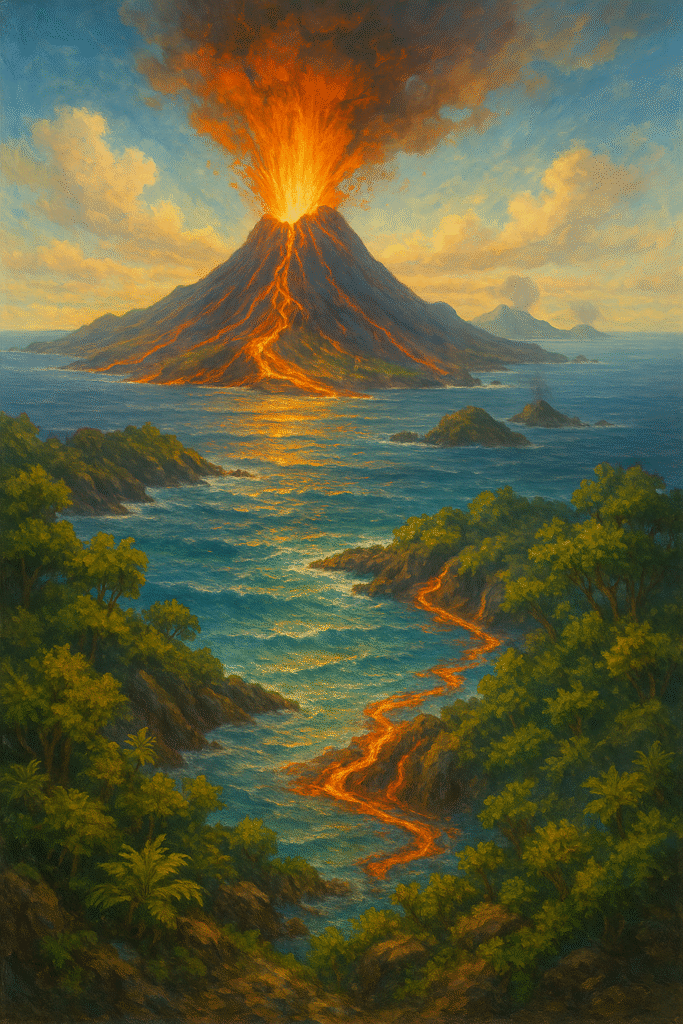While often associated with destruction, volcanoes are one of Earth’s most powerful creative forces. These geological giants are responsible for shaping vast areas of our planet, and nowhere is this more evident than in the birth of new lands from the sea. This guide explores the fascinating process of volcanic island formation, revealing how these fiery events lead to the development of unique ecosystems and rich biodiversity. We’ll delve into the science behind how fire builds islands and examine iconic examples of islands like Hawaii and Iceland, which stand as testaments to the life-giving power of volcanoes.
Volcanoes as Creators
* Island Birth: Volcanic eruptions on the ocean floor build up layers of lava that eventually breach the surface, forming new islands.
* Two Main Processes: Islands are primarily formed by stationary ‘hotspots’ under moving tectonic plates (like Hawaii) or at the boundaries of diverging plates (like Iceland).
* Ecological Hotbeds: The isolation and nutrient-rich volcanic soil of these islands foster unique ecosystems and a high number of endemic species—life found nowhere else on Earth.
* Human Connection: Beyond geology, volcanic regions are centers of cultural significance and provide renewable resources like geothermal energy from volcanoes.
The Fiery Forge: How Volcanoes Build Islands from the Ocean Floor
The journey from a deep-sea eruption to a lush, life-filled island is a cornerstone of the geological impact of volcanoes. This process unfolds over millennia, driven by immense heat and pressure from within the Earth.
The Geological Processes of Volcanic Island Formation
The creation of a volcanic island is a step-by-step process of accumulation and growth, driven by different types of volcanic activity.
1. Submarine Eruptions: The process begins with volcanic eruptions deep underwater. When molten magma meets cold seawater, it cools rapidly into pillow lava formations. Repeated volcanic eruptions and island formation are linked, as each event adds another layer, slowly building a seamount towards the ocean’s surface.
2. Hotspot Volcanism: A primary mechanism for creating island chains is hotspot volcanism. A hotspot is a fixed point of intense heat in the Earth’s mantle that funnels magma upward. As a tectonic plate drifts over this stationary hotspot, a series of volcanoes erupt, forming a chain of islands. The Hawaiian Islands are the textbook example of this process, showcasing a timeline of island creation.
3. Tectonic Plate Boundaries: Island arcs often form at subduction zones, where one tectonic plate is forced beneath another. The Aleutian Islands are a prime example. Additionally, at divergent boundaries where plates pull apart, like the Mid-Atlantic Ridge where Iceland sits, magma rises to fill the gap, fueling constant Iceland volcanism and land creation.
Living Laboratories: Volcanic Islands Like Hawaii and Iceland
To witness volcanoes that create life in action, we can look to Hawaii and Iceland. These locations are not just tourist destinations; they are active geological workshops and vibrant ecosystems in volcanic regions.
Hawaiian Volcanic Activity: The Hotspot Island Chain
Hawaii is a direct result of hotspot volcanism. The ongoing Hawaiian volcanic activity provides a living study of island evolution.
* Island Creation: As the Pacific Plate has moved northwest over a stationary hotspot for millions of years, it has created the Hawaiian-Emperor seamount chain, with the Big Island of Hawaii being the youngest and most active.
* Hawaii Volcano Ecosystems: The varied ages and elevations of the islands have created a stunning diversity of habitats. From the barren, new lava fields of Kilauea to the ancient, lush rainforests of Kauai, these environments support a vast array of life. This isolation has led to remarkable endemism, including the Nene (Hawaiian goose) and the vibrant silversword plant that thrives on volcanic slopes.
* Cultural Heartbeat: For Native Hawaiians, volcanoes are sacred. The goddess Pele, who is believed to dwell in the Halemaʻumaʻu crater of Kīlauea, represents the destructive and creative power of volcanoes, deeply embedding this geological force into the cultural fabric.
Iceland Volcanism: Where Fire Meets Ice
Iceland, the ‘Land of Fire and Ice’, offers a different but equally dramatic story of creation. Its existence is due to the unique combination of a hotspot and its position on the Mid-Atlantic Ridge.
* A Land Forged by Tectonic Divergence: The constant pulling apart of the Eurasian and North American plates fuels Iceland’s 30 active volcanic systems. This activity has not only built the main island but also created smaller Iceland volcanic islands like Surtsey, which emerged from the ocean in the 1960s and became a pristine laboratory for studying ecological succession.
* A Landscape of Contrasts: The interplay of fire and ice creates a landscape unlike any other, featuring vast lava fields, powerful geysers, glaciers, and black sand beaches. This unique environment is a major draw for tourism, with Iceland volcano tours being a popular activity.
* Resilient Ecosystems: Despite its harsh conditions, the nutrient-rich volcanic soil supports a surprising amount of flora, which in turn supports diverse birdlife, including the iconic Atlantic Puffin.
Harnessing the Earth’s Power: Geothermal Energy and Other Benefits
The benefits of volcanic activity extend beyond land creation. Regions with active volcanism are rich in resources, particularly renewable energy.
One of the most significant advantages is access to geothermal energy from volcanoes. In places like Iceland, heat from underground magma chambers is used to boil water, creating steam that drives turbines to generate clean electricity. This process provides heating and power to the vast majority of the country. Volcanic regions also boast fertile soils perfect for agriculture and are sources of valuable minerals and construction materials.
Living with Giants: Culture and Biodiversity Near Volcanoes
Living near volcanoes requires a balance of respect, adaptation, and understanding. The same forces that pose a risk also provide the foundation for life and culture.
The Ecological Boom: Volcanic Soil and Biodiversity
Volcanic islands are often referred to as cradles of evolution. Their isolation prevents species from the mainland from easily colonizing, allowing new arrivals to evolve into unique forms. The fertile volcanic soil fertility, enriched by ash and weathered lava, creates a lush foundation for plant life, which then supports complex food webs. This combination of isolation and fertility is why volcanoes and biodiversity are so closely linked, making these islands hotspots of endemism.
Human Connection and Cultural Significance
Throughout history, humans have been drawn to volcanic regions for their fertile land. This proximity has fostered a deep cultural connection. Mythologies worldwide feature volcano deities, reflecting humanity’s awe and respect for these powerful natural phenomena. Today, this relationship continues, with economies in volcanic regions often centered around tourism and agriculture, showcasing a modern symbiosis between humans and the dynamic Earth.
Conclusion: The Creative Force of Earth’s Volcanoes
Volcanoes are profound agents of change, demonstrating that from fiery destruction comes vibrant creation. The story of how volcanoes build islands is a powerful reminder of our planet’s dynamic nature. From the formation of new landmasses like Hawaii and Iceland to the fostering of unique life created by volcanoes, these geological wonders are essential architects of our world. Understanding and preserving these incredible environments is crucial for protecting global biodiversity and appreciating the deep connection between the planet’s inner fire and the life it supports on the surface.
Frequently Asked Questions (FAQ)
What is the role of volcanoes in island formation?
Volcanoes build islands by erupting lava and ash from the ocean floor. Over countless eruptions, this material accumulates until it rises above sea level, forming a new island. This process is known as volcanic island formation.
How do volcanic islands support such high biodiversity?
Volcanic islands act as isolated natural laboratories. Their rich volcanic soil supports plant growth, and their isolation leads to adaptive radiation, where species evolve to fill unique ecological niches, resulting in a high number of endemic species not found elsewhere.
What are the benefits of volcanic activity?
Key benefits include the creation of extremely fertile soil for agriculture, the formation of valuable mineral deposits, and the generation of clean, renewable geothermal energy. They also create unique landscapes that drive tourism.
How is geothermal energy produced by volcanoes?
In volcanic areas, magma close to the surface heats underground water sources. This hot water or steam is then tapped through wells and used to spin turbines, generating electricity in a clean and sustainable way.
Why is it important to conserve volcanic ecosystems?
Conserving these ecosystems is vital because they are hotspots of biodiversity, home to many unique and endangered species. They are also culturally significant and provide valuable scientific insights into geology and evolution.

